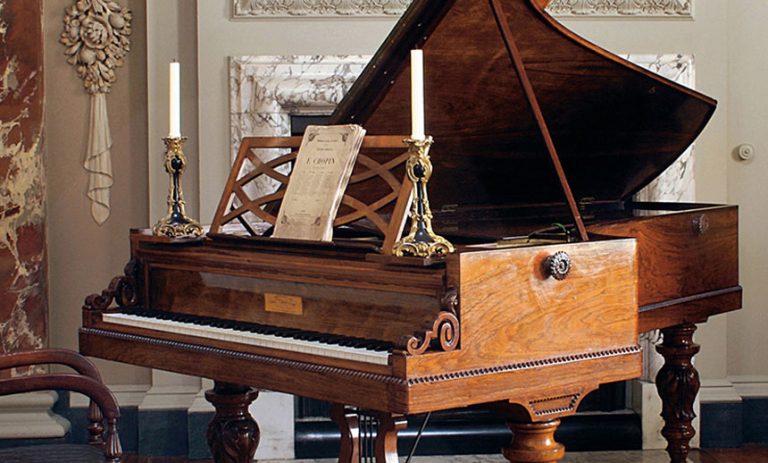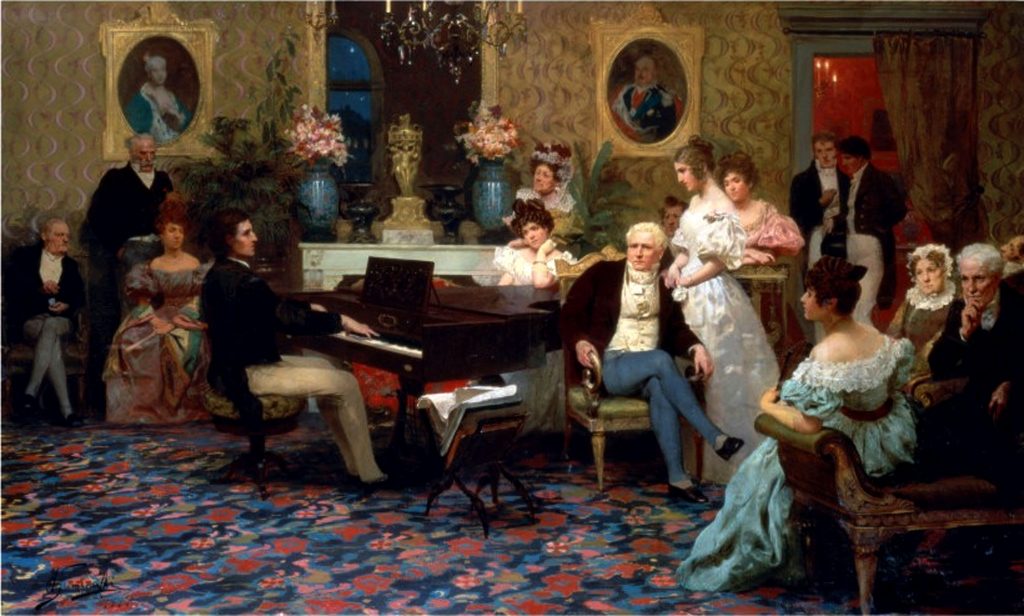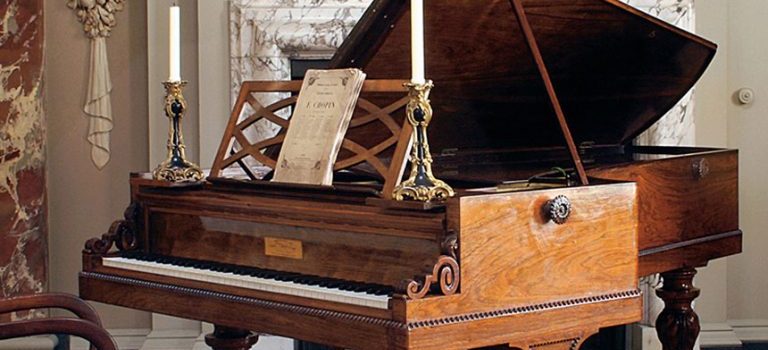If you’re looking for information on the French brand Pleyel, you couldn’t have come to a better place! Here you will find facts about the Pleyel brand, as well as glimpses of the Polish-French friendship with Chopin and the cultural life at the Salle Pleyel. You will also find out how much Pleyel pianos are worth, a brief overview of the models and the age of your instrument!
Table of contents

1. About the Pleyel brand
Let’s start from the beginning… It was in Europe that the whole industry of manufacturing first grand pianos and then upright pianos was born, which gradually “took over” the whole world. The inventor of the first grand piano in the world, Cristofori, obviously came from Italy, and that is why this country is considered to be the cradle of pianos. However, the development of the instrument, the many improvements and the involvement in its production are particularly attributed to Germany. By comparison, the most famous and respected piano brand, Steinway & Sons, was only founded in America in 1853 (thanks to the efforts of German emigrant Heinrich Steinweg).
Austrian composer starts piano production in France
When writing about Pleyel, however, we move to France. It was here that Ignaz Pleyel – musician and composer, of Austrian origin – began his business at the beginning of the 19th century. The company, founded in 1807, was originally called “Pleyel et Cie (Pleyel & Co.). It was another idea of Ignaz, who had previously enjoyed great success as a musician, and as a publisher of sheet music and musical works.
The successes of the Pleyel factory had to wait a while and a lot of effort had to be put into production. Although it was during Ignaz’s lifetime that the brand became very well-known and respected, the first years brought more losses than benefits. The builders under Ignaz Pleyel’s supervision did not give up their efforts, although it was only after more than a decade that the company began to visibly increase its efficiency. In the 1920s, the Pleyel piano was recognised and awarded at an international exhibition, and there were more and more successes. In addition to the French courts, instruments also reached other European countries and soon beyond.
Salle Pleyel – centre of culture and the career of Frideric Chopin in Paris
After the death of his father in 1831, Camille took over the company (which he had already managed in earlier years) and ran it together with Auguste Wolff. Interestingly, thanks to Camille, the activities of the Pleyel brand reached even further – an important part of the cultural activities was the foundation of the so-called “Salle Pleyel” 20 years later. Their role was significant in the beginnings and development of the careers of many artists, including Fryderyk Chopin. He performed at the Pleyel salons from the 1830s – his debut took place in 1832.
Chopin was definitely not a musician who enjoyed giving concerts; he himself wrote many times about the enormous stress he experienced before a performance. About 20 of Chopin’s concerts took place in Salle Pleyel, which is an impressive number – considering the fact that in his entire adult life Fryderyk Chopin gave concerts only 30 times. He also played his last concert in the Salons in 1848. Fryderyk and Camille shared a close relationship, documented in the biographers’ collections and evident in the correspondence which the friends exchanged between themselves.
It is remarkable that the Pleyel salons played a key cultural role in Paris as a major concert hall until 2015! It is worth mentioning that the Pleyel brand was a firm favourite of Frederic Chopin. He preferred Pleyel pianos and it was on these that Chopin practiced and composed. More interesting facts about his last instrument can be found here.

Pleyel pianos were also chosen by artists such as Claude Debussy, Edward Grieg, Maurice Ravel, Arthur Rubinstein, Camille Saint-Saëns, Igor Stravinsky and Richard Strauss.
The instruments were improved and awarded prizes, and sales branches outside Paris were also located in Britain, Belgium, and Australia. One of the key technical innovations included bracing in the form of wrought iron bars to a wooden frame (1825). This was not an all-iron frame (this was introduced at a similar time in the USA), although references to this can also be found. An important invention – already from the 20th century – was the “Pleyela”, modelled on the American pianola.
After Camille’s death, the company was successfully managed by August Wolff for about 30 years. Gustave Lyon, an engineer who managed the company at the turn of the 20th century, then went down in company history as an owner and innovator.
Pleyel, Gaveau Érard or Schimmel? The fate of the company in the 20th and 21st centuries
One of the most difficult periods for the company was the 1930s, when the piano industry was not spared by the economic crisis. The range of production gradually decreased and this trend did not change for the better. It was first decided to transform the company into a joint stock company (Pleyel SA). In 1961, Pleyel entered into a partnership with the already merged Gaveau-Érard brands (once the main competitors). However, 10 years later the three cooperating brands were bought out by the Schimmel factory. It was only after 23 years that production moved back to France. It is therefore worth noting that all Pleyel, Gaveau, and Érard pianos made from 1971 to 1994 were modelled on Schimmel products and made in the German factory in Braunschweig.
The return to France came through the Musique Partenaires, and Rameau companies. As the 21st century began, Hubert Martigny – the new owner of Salle Pleyel – bought out these three brands, transforming them into Manufacture Française de Pianos. This was a major event, as Pleyel pianos once again arrived in the ‘Salons’. However, production ceased in 2013. This moment was for a short time considered to be the final end of the Pleyel company. However, 3 years later – in 2016 – the brand was bought out again by the European musical instrument distributor Algam. This event resulted in the creation of a new French factory, and plans to start Asian production (Pleyel China).
Thus, the Pleyel brand has been on the market for over 200 years!
2. Pleyel upright and grand piano models
One of the most popular grand pianos was the 164cm long 3-bis model. It was the prototype of the F model, which has been named so since 1926, after a change in frame design, among other things. By the time Schimmel took over the company (1971), some 15,000 of these pianos had been produced, and these pianos are ideal for restoration. The Model 3 (204 cm) produced between 1906 and 1937 was also extremely popular.
On the other hand, in the 1950s, Grand Patron concert grand pianos (245cm) were popular. Among the concert models, we can also distinguish Model 1 and AL.
Examples of designer grand pianos, collector pianos, made from a combination of unique types of wood, produced in small numbers include the 1937 by Jacques-Emile Ruhlmann (it is a replica of the original from 1937) or the Dream by Alberto Pinto (only 3 models were produced)
For more information on contemporary models, regularly produced, and unique collector pianos, click here.
Below is a brief overview of contemporary Pleyel upright and grand piano models:
PIANOS
| Model | Height | Width | Length | Weight | Price |
| P124 | 124 cm / 49″ | 148 cm / 58″ | 63 cm / 25″ | 235 kg / 518 ibs | Check out klaviano |
| P131 | 131 cm / 51″ | 149 cm / 58″ | 66 cm / 26″ | 260 kg / 573 ibs | Check out klaviano |
GRAND PIANOS
| Model | Height | Width | Length | Weight | Price |
| P170 | 104 cm / 41″ | 150 cm / 59″ | 173 cm / 5’8″ | 327 kg / 720 ibs | Check out klaviano |
| P190 | 103 cm / 41″ | 150 cm / 59″ | 190 cm / 6’2″ | 352 kg / 776 ibs | Check out klaviano |
| F170 | 104 cm / 41″ | 150 cm / 59″ | 174 cm / 5’8″ | 327 kg / 720 ibs | Check out klaviano |
| F190 | 104 cm / 41″ | 150 cm / 59″ | 190 cm / 6’2″ | 352 kg / 776 ibs | Check out klaviano |
3. How much are Pleyel grand pianos worth?
Considering the long history of the Pleyel brand, it is important to consider the variety of instruments produced in the factories over the years. It is certainly possible to find a whole range of upright and grand pianos in various states of ‘wear and tear’ on the market – some older instruments never restored, other pianos partially restored, or newer pianos ready to play. For this reason, it is almost impossible to provide a price framework.
But we have a solution! Klaviano offer professional assistance in determining an approximate price to enable owners to assess the value of a Pleyel instrument. We also suggest that you check how much Pleyel instruments cost on the Klaviano search engine.
4. When was my Pleyel piano produced?
For the answer to this question, be sure to check the serial number of your instrument and then locate it within the date range below:
5. I want to buy/sell a Pleyel piano
Maybe you are planning to sell your Pleyel instrument and are wondering how to do it? We’re glad you came here! This is the perfect place to sell your Pleyel piano.
The purpose of the Klaviano portal is to connect the customer and the dealer. Thus, you can both add your offer and find interesting instruments in your area.
If you have any doubts or questions about the Pleyel brand, you can also contact your Klaviano consultant.

